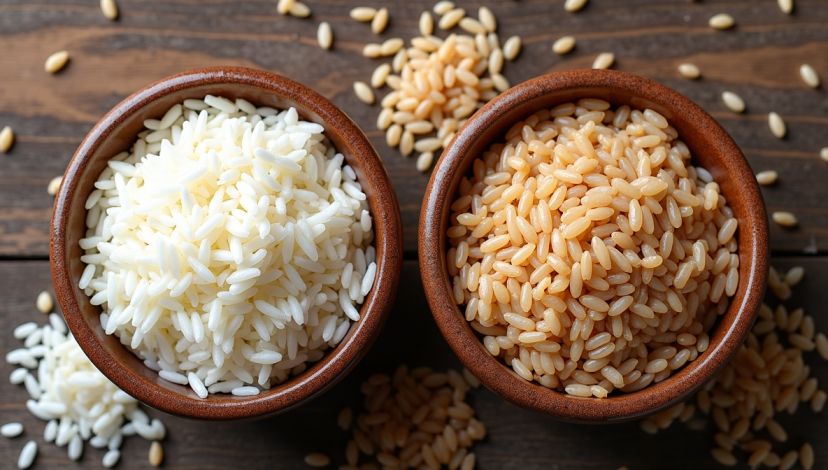White Rice vs Brown Rice: Which One Is Healthier?

Billions of people across the world consume rice as a major food item; however, when the issue becomes which is healthier: white or brown rice, the question arises among people. They derive both from the same grain, yet processing, nutrition, and taste set them apart. This blog post will explore the differences between white rice vs brown rice, helping you make an informed choice that fits your dietary needs and preferences.
Table of Contents
- What are the primary distinctions between brown and white rice?
- What are Some Comparisons between the Nutritional Values of White Rice and Brown Rice?
- Which Rice Is Better for Managing To Reduce Weight and Blood Sugar?
- What Are The Differences In Taste And Cooking Methods In White Rice Vs Brown Rice?
- Does Brown Rice Or White Rice Contain Health Risks Or Concerns?
- Conclusion
- FAQ’s
Key Points:
- Whereas brown rice has the higher nutrients and fiber than the white rice.
- White rice takes a shorter time to cook and is soft.
- The options between them are dependent on health objectives and personal preferences.
What are the primary distinctions between brown and white rice?
Both white rice and brown rice come from the same grain, but processors treat white rice differently.Brown rice is a complete grain, which retains its bran germ and the endosperm. It means retaining more fiber, vitamins, and minerals. Milling, on the other hand, removes the bran and germ of white rice, leaving only the starch endosperm. It prolongs shelf life and causes white rice to cook shorter time; however, it also removes many nutrients.
Brown rice contains higher amounts of magnesium, phosphorus, and B vitamins, while manufacturers typically add vitamins back into white rice after processing to make up for the loss. Its texture is also different: brown rice is harder to chew, and it has a nutlike aroma, whereas white rice is soft and fluffy. Such a contrast can influence the times of cooking and the way you should use them in recipes.
What are Some Comparisons between the Nutritional Values of White Rice and Brown Rice?
The brown rice is comparatively nutritionally better as it contains more fibres and micronutrients. One intake of cooked brown rice contains higher fiber levels, magnesium, as well as antioxidant concentrations, as compared to the same quantity of white rice. The fiber gives significance to digestion, blood sugar, and the condition of the heart.
The following is a breakdown of the comparison table of a 1/3 cup cooked serving:
| Nutrient | Brown Rice | White Rice |
| Calories | 82 | 68 |
| Protein (g) | 1.83 | 1.42 |
| Total Fat (g) | 0.65 | 0.15 |
| Carbohydrates (g) | 17.05 | 14.84 |
| Dietary Fiber (g) | 1.1 | 0.2 |
| Magnesium (mg) | Higher | Lower |
| Iron (mg) | 0.37 | 0.63 |
Brown rice contains more fiber and this delays digestion, and it has the potential to regulate the energy level and the sugar in the blood. White rice has less fiber and digests faster, and could lead to a quicker rise in blood sugar, which is a factor to consider by diabetic individuals.
Note: Although brown rice is more nutrient-dense and, therefore, healthier to consume, white rice may be simpler to digest for some people.
This is to noting that white rice may be fortified with a wide range of vitamins, such as folate, to re-package the nutrients lost during processing.
Which Rice Is Better for Managing To Reduce Weight and Blood Sugar?
Brown rice is better in terms of weight management and maintaining blood sugar because it contains fiber and shows a low glycemic index. Low-glycemic foods result in less blood sugar than high-glycemic foods, thereby aiding in the control of hunger and energy.
Research indicates the possibility of the substitution of white rice with brown in order to mitigate type 2 diabetes and enhance the glycemic response in individuals with metabolic issues. The fiber in brown rice also makes you feel full and therefore may help in weight control, as one does not eat too much.
There may, however, be a preference for white rice among those individuals needing a low-fiber diet, like people with some digestive problems. It is also more digestible and takes less time to cook, which is convenient.
| Aspect | Brown Rice | White Rice |
| Glycemic Index | Lower | Higher |
| Fiber Content | Higher | Lower |
| Effect on Blood Sugar | More stable | Faster spikes |
| Satiety (Fullness) | Higher | Lower |
Notice: This can be true when the choices are made between brown rice and white rice, especially in people with diabetes or pre-diabetes.
Note: White Rice is an alternative to use temporarily in case you have some digestive matters that need low fiber foods.
What Are The Differences In Taste And Cooking Methods In White Rice Vs Brown Rice?
Some practical differences between white rice and brown rice are the input of taste and cooking time. Brown rice is more nutty, chewy, and others prefer it this way because it is more flavorful. It is, however, more time-consuming in preparation and usually requires up to 40-50 minutes as opposed to 15-20 minutes of white rice.
White rice is gentler and bland in taste, and thus it can be used in most of the meals such as sushi, pilafs, and casseroles. Since it takes a shorter time to cook, it is usually used when one has little time.
To cook brown rice, it can be soaked with a boil so that it will be less to cook and that it will taste good. White rice does not always take much preparation and takes up water fast.
These two can be utilized interchangeably in most of the recipes, but the texture and the time used in cooking may alter the end product.
Does Brown Rice Or White Rice Contain Health Risks Or Concerns?
Although many consider brown rice healthier, it may also contain higher levels of arsenic—a toxin that naturally occurs in soil and water. The outer layers of the grain accumulate more arsenic, and since brown rice retains these layers, it holds more of the toxin. As a measure of prevention of arsenic, food experts recommend rinsing rice and cooking it in a lot of water.
The white rice has less arsenic and less nutrients. Moreover, because of their elevated glycemic index, white rice may increase the level of sugar in the blood to high levels when taken in excessive amounts.
Moderate usage of either type of rice is safe for the majority. The ideal method is to balance the consumption of rice with the other whole grains and a diverse diet.
Conclusion
Choosing between white rice vs brown rice depends on your health goals, taste preferences, and lifestyle. Brown rice has more fibers, vitamins, and minerals, thus it is healthy for the stomach, blood sugar, and heart. White rice, on the other hand, takes less time to cook and is easily digestible, and in some instances, this is advantageous.
The key to it is to include both of them in your diet, as this would be a source of variety and balance. Brown rice tends to be more effective when it comes to managing blood sugar levels or weight. White rice can be used when one wants a fast meal or when they are in need of low amounts of fiber.
Finally, awareness of the differences will enable you to make the most appropriate decision concerning your diet and take pleasure in consuming rice as a healthy staple.
FAQ’s
1. Which one is healthier to consume, brown or white rice?
Yes, brown rice is healthier as a whole since it will contain a great deal more fiber, vitamins, and minerals as opposed to white rice.
2. Does brown rice burn fat?
When consumed as a part of a balanced diet, brown rice can enhance satiety, as well as stimulate weight control due to its high fiber composition.
3. Is it possible to eat white rice by a patient with diabetes?
Diabetic patients need to avoid consuming a lot of white rice because it has a superior glycemic index that causes the body to regulate much blood sugar.
4. Why is there a difference in the time of cooking brown and white rice?
Brown rice contains bran and germ, making it more dense and thus needs a longer time to cook.
5. Does brown rice contain any threat of arsenic?
Brown rice may actually have higher levels of arsenic than white rice, though washing and cooking of the food can help mitigate the danger.
Latest Posts
You Might Also Like

Chipotle Nutrition – Your go-to guide for calories, healthy choices, and balanced meals at Chipotle.
TOP NEWS
© Copyright 2025 Chipotle Nutrition. All rights reserved














No Comments